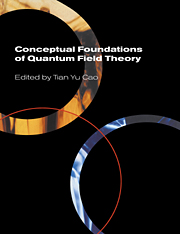Book contents
- Frontmatter
- Contents
- List of contributors
- Preface
- Photographs of the conference
- Introduction: Conceptual issues in quantum field theory
- Part One Philosophers' interest in quantum field theory
- Part Two Three approaches to the foundations of quantum field theory
- Part Three
- Part Four Mathematics, statistics and quantum field theory
- 8 Renormalization group theory: its basis and formulation in statistical physics
- 9 Where does quantum field theory fit into the big picture?
- 10 The unreasonable effectiveness of quantum field theory
- 11 Comments: The quantum field theory of physics and of mathematics
- Part Five Quantum field theory and space-time
- Part Six
- Part Seven Renormalization group
- Part Eight Non-Abelian gauge theory
- Part Nine The ontology of particles or fields
- Part Ten
- Name index
- Subject index
9 - Where does quantum field theory fit into the big picture?
Published online by Cambridge University Press: 22 September 2009
- Frontmatter
- Contents
- List of contributors
- Preface
- Photographs of the conference
- Introduction: Conceptual issues in quantum field theory
- Part One Philosophers' interest in quantum field theory
- Part Two Three approaches to the foundations of quantum field theory
- Part Three
- Part Four Mathematics, statistics and quantum field theory
- 8 Renormalization group theory: its basis and formulation in statistical physics
- 9 Where does quantum field theory fit into the big picture?
- 10 The unreasonable effectiveness of quantum field theory
- 11 Comments: The quantum field theory of physics and of mathematics
- Part Five Quantum field theory and space-time
- Part Six
- Part Seven Renormalization group
- Part Eight Non-Abelian gauge theory
- Part Nine The ontology of particles or fields
- Part Ten
- Name index
- Subject index
Summary
Looking back on foundations
For centuries we have said that mathematics is the language of physics. In 1960 Eugene Wigner wrote the famous article expounding the ‘unreasonable effectiveness of mathematics in the natural sciences’ [Wig]. He concludes that lecture by stating, ‘… the miracle of the appropriateness of the language of mathematics for the formulation of the laws of physics is a wonderful gift which we neither understand nor deserve. We should be grateful for it and hope that it will remain valid in the future and that it will extend… to wide branches of learning.’
Two basic questions have driven mathematical physics. First, what mathematical framework (basically what equations) describes nature? Once we decide on the equations, one can ask the second question: what are the mathematical properties of their solutions? We would like to know both their qualitative and quantitative properties. While it appears reasonable to answer these questions in order, they may be intimately related.
In that vein, let us inquire about the foundations of quantum electrodynamics. In this area of physics we encounter the most accurate quantitative and qualitative predictions about nature known to man. The Maxwell-Dirac equations are well accepted in their individual domains. But combined as a nonlinear system of equations, they lead to agreement between perturbation theoretic rules on the one hand - and to experiment on the other - that startles the imagination.
- Type
- Chapter
- Information
- Conceptual Foundations of Quantum Field Theory , pp. 136 - 147Publisher: Cambridge University PressPrint publication year: 1999
- 12
- Cited by

